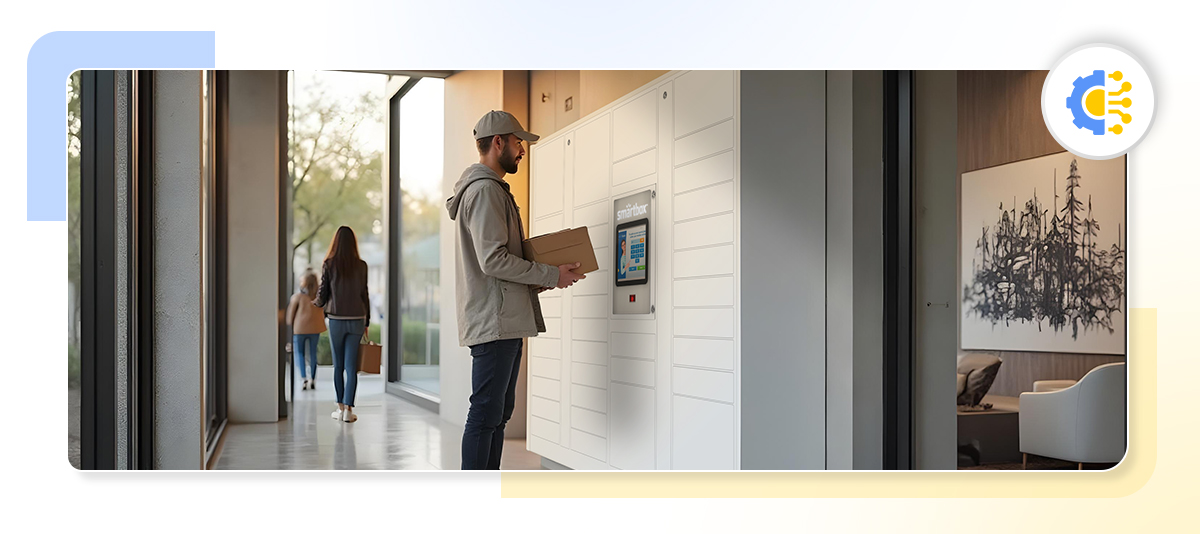Smart lockers are no longer just a futuristic idea – they’re fast becoming a cornerstone of modern logistics. From busy urban neighborhoods to large-scale warehouse hubs, these intelligent systems are reshaping how parcels are delivered, stored, and collected. Whether it’s improving last-mile delivery, enhancing package tracking, or boosting customer satisfaction, smart logistics lockers offer undeniable value to both consumers and logistics providers.
But let’s be honest: integrating smart package lockers into real-world logistics operations – especially in complex 3PL ecosystems – isn’t as simple as plugging in a new device and walking away. There are real hurdles to overcome. Think: system compatibility issues with existing transportation management systems, ongoing maintenance concerns, security risks, and even staff training requirements. Not to mention the very real fear of adoption barriers like data privacy and scalability headaches.
If you’re a logistics provider or part of a third-party logistics (3PL) network trying to make sense of it all, this blog is for you. We’ll unpack the key smart locker integration challenges, explore their impact on delivery optimization and operational efficiency, and offer practical strategies to overcome them. Whether you’re navigating technology adoption, trying to cut costs, or simply want to improve the user experience, we’ll show you how to make smart locker solutions work for your business, not against it.
How the Smart Locker Revolution is Disrupting the Logistics Industry
Gone are the days when parcels sat on porches or got rerouted endlessly due to missed deliveries. Smart lockers – secure, automated storage systems – are rewriting the rules of last-mile delivery logistics. Found everywhere from high-rise apartments and college campuses to busy retail stores and transit hubs, these smart package lockers offer a seamless, contactless way to send and receive goods.
For logistics and supply chain management professionals, the benefits are clear. Smart locker integration brings a host of operational advantages, including:
- Dramatically lower last-mile delivery costs
- A sharp decline in failed deliveries and reattempts
- A more frictionless, reliable customer experience
- Higher levels of parcel security and inventory control
The promise of smart logistics lockers is exciting, but getting from point A to point B is no small feat. Transitioning from traditional courier models to a locker-driven ecosystem requires more than just installing hardware. It demands smart planning, a deep understanding of 3PL integration, and the ability to overcome various technical hurdles, system compatibility concerns, and even user experience design challenges. As this revolution gains momentum, logistics providers must evolve – not just with the technology itself, but with the processes, teams, and tools that support it.
Solving the Key Challenges of Smart Locker Integration in Logistics
Integrating smart lockers into the heart of your logistics operations sounds like a tech dream – until you’re knee-deep in legacy code, mismatched APIs, and resistant delivery teams. While smart parcel locker technology has immense potential to streamline 3PL operations, boost delivery optimization, and enhance the user experience, the road to full-scale technology adoption isn’t always smooth.
Let’s break down the biggest hurdles logistics providers face when rolling out smart locker systems and how to navigate them effectively.
Technical Hurdles
1. Legacy System Integration
Many logistics providers and third-party logistics (3PL) companies still rely on legacy transportation management systems (TMS) and outdated IT infrastructure. These older systems were never built to connect with the cloud-based APIs that power most modern smart logistics lockers. Bridging this gap often requires custom middleware, IT architecture overhauls, or significant investments in system compatibility and modernization.
2. Data Security and Privacy
Smart lockers don’t just store parcels – they process sensitive customer data, from personal addresses to real-time shipment tracking details. That makes data security and privacy compliance top priorities. End-to-end encryption protocols, secure user authentication, and adherence to privacy laws like GDPR and CCPA are essential to protect both businesses and consumers from cybersecurity risks.
3. Real-Time Data Synchronization
Automation in logistics only works when all systems talk to each other – fast. For smart locker integration to function smoothly, there needs to be seamless, real-time synchronization between inventory management, order fulfillment, and routing software. Any delays, mismatched data, or system silos can lead to failed deliveries, inaccurate inventory records, and a drop in customer satisfaction.
System Compatibility
1. Diverse Locker Vendors and Standards
The smart locker market is booming – and fragmented. From hardware to software, different vendors come with different communication protocols and user interfaces. This lack of standardization makes it difficult for logistics providers to create a unified smart locker supply chain strategy, especially when juggling multiple locker types across different regions.
2. API and Protocol Incompatibility
APIs are the glue that holds modern logistics technology together. But when smart locker APIs are poorly documented, inconsistent, or incompatible with existing logistics and supply chain management platforms, integration becomes a drawn-out, error-prone process that slows down deployment and adds to operational inefficiency.
3. Scalability Issues
What works for ten lockers in one city may not work for 1,000 lockers across a nationwide network. If the smart locker solution isn’t modular, flexible, or cloud-scalable, you’ll hit a wall. Scalability is key for future-proofing your operations — from last-mile delivery logistics to high-volume 3PL integration.
Operational Disruptions
1. Process Redesign
Introducing parcel delivery lockers means reimagining your delivery workflows. Couriers must learn new drop-off protocols, digital access systems, and potentially new routing methods. Without clear process maps and onboarding, confusion can derail even the best logistics technology rollouts.
2. Change Management
One of the biggest hidden challenges? People. Employees often view new tech as a threat to their roles, routines, or comfort zones. Implementing smart storage solutions means addressing these fears head-on with solid change management, ongoing training, and transparent communication to avoid productivity dips and resistance.
3. Service Downtime and Maintenance
Even the smartest lockers can go offline. And when they do, last-mile delivery solutions grind to a halt. Whether it’s a software bug, power outage, or wear and tear, maintenance issues can trigger delays, bottlenecks, and complaints. Having proactive diagnostics and rapid-response teams is vital to avoid customer dissatisfaction.
Strategies for Overcoming Smart Locker Integration Roadblocks in Logistics
Smart lockers can absolutely transform the way logistics and supply chain management function – but only if the integration is handled smartly. From system compatibility to data privacy, every hurdle has a solution – if you know where to look. Let’s explore practical, scalable strategies to tackle these challenges and unlock the full power of smart locker technology in your logistics operations.
- Prioritize Open, Modular, and Scalable Solutions
Future-proof your logistics stack by choosing smart locker solutions that are open API-driven, cloud-native, and modular. That means no more struggling with rigid systems that can’t grow with you. Whether you’re handling a few dozen parcels for delivery or scaling to a national rollout, modular locker units and flexible integrations will ensure you maintain operational efficiency.
- Look for vendors with proven 3PL integration experience.
- Select cloud-based locker platforms to ensure real-time access and better package tracking.
Build with scalability in mind – your smart storage solution should grow with your business, not limit it.
- Invest in Middleware and Integration Platforms
If you’re still relying on legacy logistics systems, tearing everything down isn’t always the answer. Instead, bridge the gap with smart middleware or Integration Platform as a Service (iPaaS) solutions like MuleSoft or Dell Boomi. These tools streamline the connection between your existing transportation management systems and new smart logistics lockers, reducing time-to-deploy and minimizing disruptions.
- Enable seamless data flow across your supply chain solutions.
- Eliminate manual data handling errors that can derail delivery optimization.
- Strengthen Data Security and Compliance
Trust is everything – especially when your lockers are storing both parcels and personal data. Prioritize cybersecurity and data protection at every touchpoint.
- Use end-to-end encryption for all locker data, in transit and at rest.
- Implement multi-factor authentication and role-based access controls for locker management dashboards.
Regularly audit locker systems for compliance with GDPR, CCPA, and other data privacy standards to avoid security risks and legal setbacks.
- Standardize Processes and Training
Even the smartest technology can stumble without the right processes behind it. Standardizing your delivery workflows and investing in comprehensive training can help your team adapt with confidence.
- Roll out standard operating procedures (SOPs) for parcel delivery lockers.
- Use digital training platforms and simulations to accelerate onboarding for couriers and customer support staff.
Focus on change management to reduce adoption barriers and ensure a smoother tech transition.
- Foster Vendor Collaboration and Ecosystem Partnerships
Integration is a team sport. Don’t go it alone – instead, build a network of collaborators who understand the nuances of logistics technology.
- Engage with locker vendors, IT providers, and 3PL technology partners early and often.
- Participate in industry forums and smart locker standardization groups to stay ahead of evolving tech protocols and best practices.
Develop long-term partnerships that support continuous improvement, not just one-time deployment.
- Implement Robust Monitoring and Maintenance Protocols
To avoid downtime, you need visibility – and lots of it. Use IoT-enabled sensors, predictive analytics, and automated alerts to keep tabs on locker health and performance.
- Schedule routine maintenance to prevent failures before they happen.
- Roll out automated software updates and security patches for long-term resilience.
Deploy quick-response teams to resolve technical issues and maintenance disruptions in real time, minimizing impact on last-mile delivery.
- Pilot and Iterate
Don’t try to boil the ocean. Instead, test your smart locker integration with a focused pilot — in a specific region, with a select customer base, or a dedicated courier team.
- Gather direct feedback from customers, drivers, and warehouse managers.
- Use real-world data to refine your processes and improve the user experience.
Once the model is optimized, scale with confidence across your wider last-mile logistics network.
By tackling these integration challenges head-on, with the right mix of tools, partnerships, and foresight, logistics providers can unlock the true potential of automated locker systems. From reducing costs to improving speed and security, smart locker supply chain strategies aren’t just a trend – they’re a game-changer.
From Now to Next: The Smart Locker-Powered Future of Logistics
The rise of e-commerce, hyper-local deliveries, and urban congestion has made one thing crystal clear — smart lockers are no longer optional; they’re essential to the evolution of last-mile logistics. As consumers demand faster, safer, and more flexible delivery options, smart package lockers are rapidly becoming a cornerstone of modern logistics technology.
For logistics and 3PL providers, the question isn’t if they should adopt smart locker systems, but how well they’ll integrate them. Those who tackle the integration challenges head-on – from system compatibility and data security to training requirements and technical hurdles – will emerge stronger, more agile, and more competitive.
By embracing open, modular systems, investing in integration platforms, and building a culture that values technology adoption and continuous improvement, forward-thinking companies can unlock major advantages. The future belongs to those who can combine innovation with execution. With the right strategy, smart locker integration becomes more than just a logistics upgrade – it becomes a catalyst for growth, a differentiator in the market, and a stepping stone toward a truly intelligent, resilient, and data-driven supply chain ecosystem.
Paving the Way Ahead
Integrating smart lockers into modern logistics operations isn’t without its challenges, but for forward-thinking 3PL providers and logistics teams, it’s a strategic leap worth taking. By addressing technical hurdles, ensuring system compatibility, and optimizing operational workflows, companies can transform integration roadblocks into opportunities for innovation, efficiency, and growth.
With the right technology, partners, and mindset, smart locker integration empowers you to offer faster, more secure, and cost-effective last-mile delivery solutions – all while boosting customer satisfaction and staying ahead in an increasingly competitive marketplace.

























